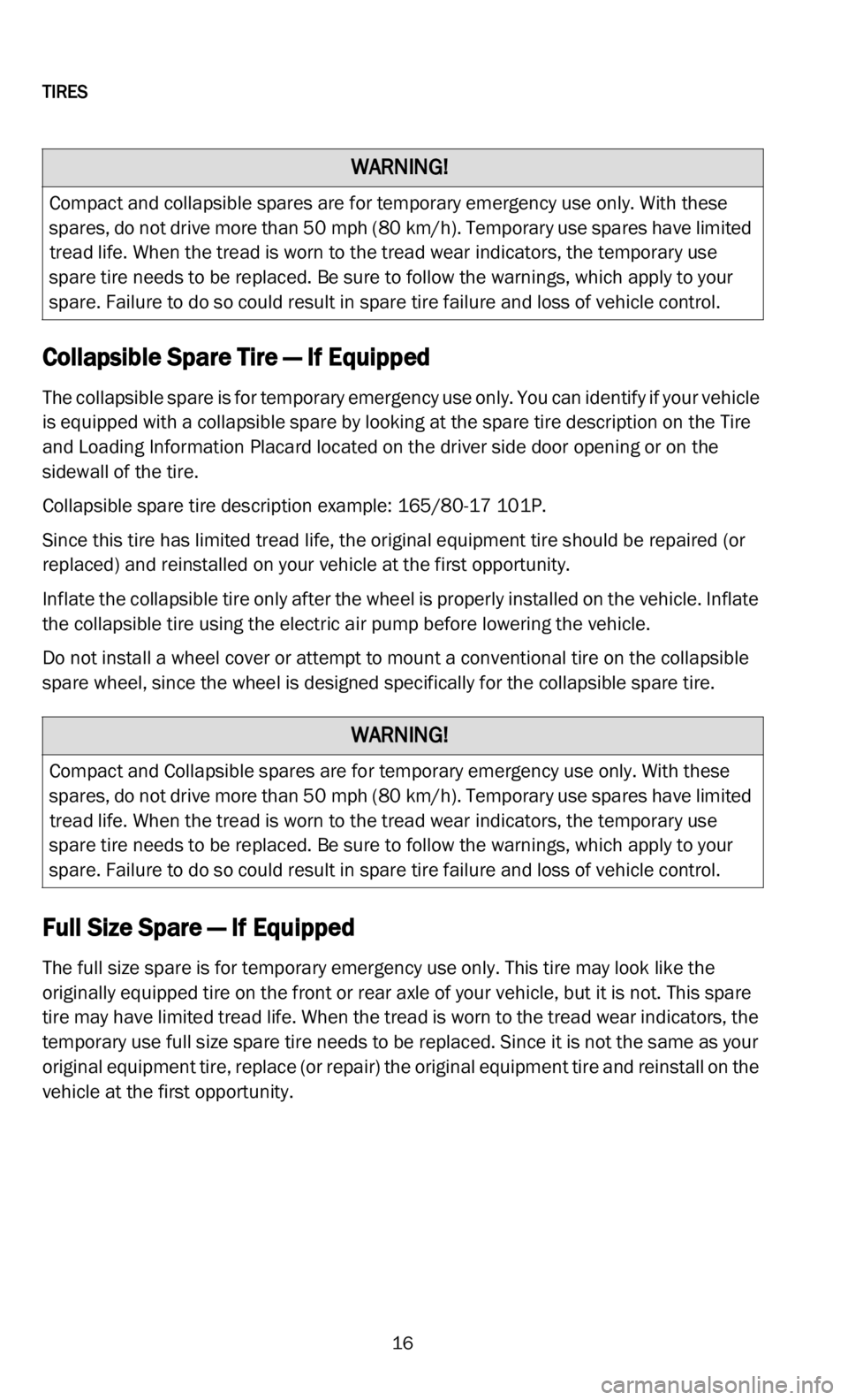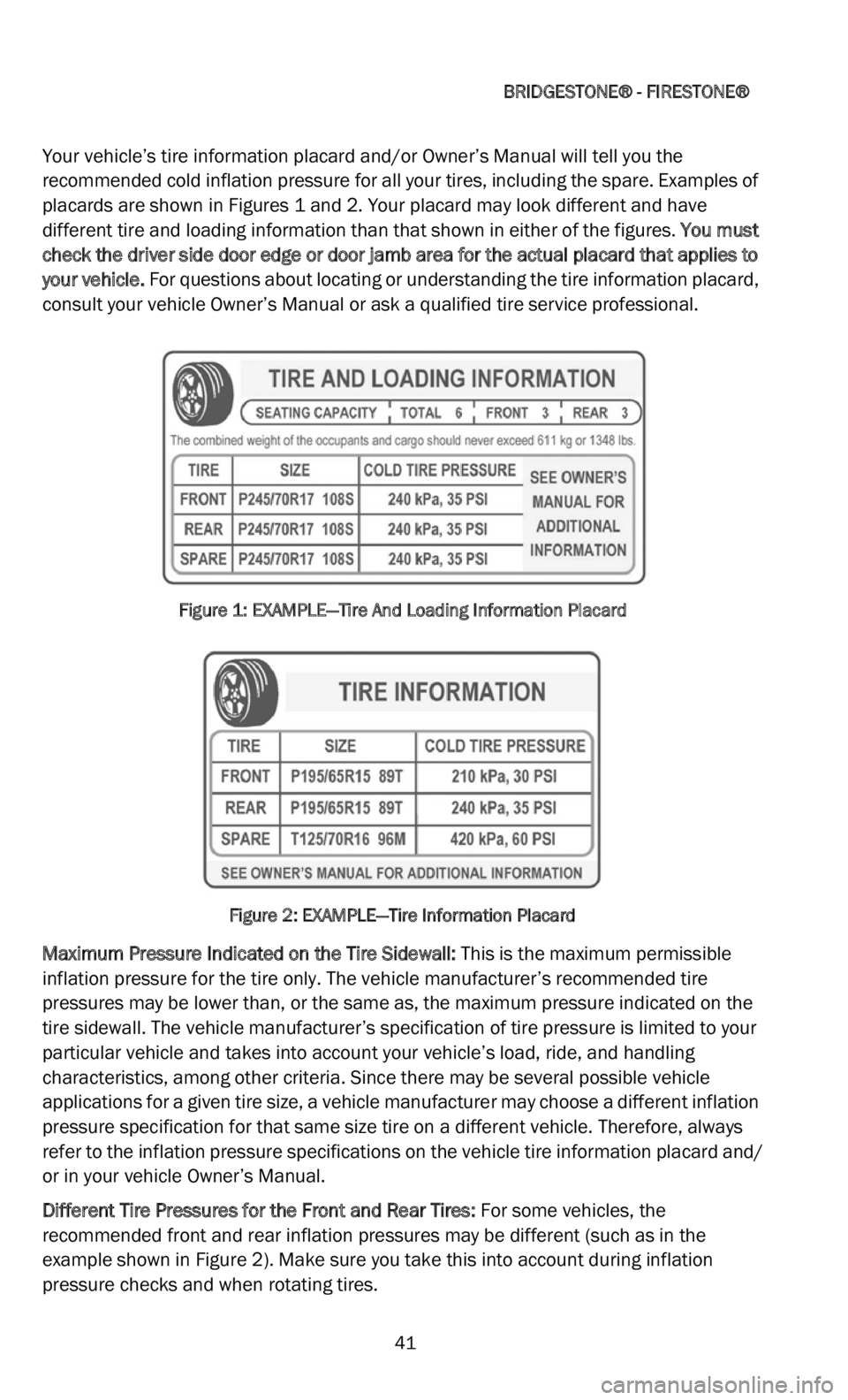tire size DODGE DURANGO 2022 Vehicle Warranty
[x] Cancel search | Manufacturer: DODGE, Model Year: 2022, Model line: DURANGO, Model: DODGE DURANGO 2022Pages: 200, PDF Size: 6.72 MB
Page 17 of 200

TIRES
16
Collapsible Spare Tire — If Equipped
The collapsible spare is for temporary emergency use only. You can identify if your vehicle
is equipped with a collapsible spare by looking at the spare tire description on the Tire
and Loading Information Placard located on the driver side door opening or on the
sidewall of the tire.
Collapsible spare tire description example: 165/80-17 101P.
Since this tire has limited tread life, the original equipment tire should be repaired (or
re
placed) and reinstalled on your vehicle at the first opportunity.
Inflate the collapsible tire only after the wheel is properly installed on the vehicle. Inflate
t h
e collapsible tire using the electric air pump before lowering the vehicle.
Do not install a wheel cover or attempt to mount a conventional tire on the collapsible
s p
are wheel, since the wheel is designed specifically for the collapsible spare tire.
Full Size Spare — If Equipped
The full size spare is for temporary emergency use only. This tire may look like the
originally equipped tire on the front or rear axle of your vehicle, but it is not. This spare
tire may have limited tread life. When the tread is worn to the tread wear indicators, the
temporary use full size spare tire needs to be replaced. Since it is not the same as your
original equipment tire, replace (or repair) the original equipment tire and reinstall on the
vehicle at the first opportunity.
WARNING!
Compact and collapsible spares are for temporary emergency use only. With these
spares, do not drive more than 50 mph (80 km/h). Temporary use spares have limited
t r
ead life. When the tread is worn to the tread wear indicators, the temporary use
spare tire needs to be replaced. Be sure to follow the warnings, which apply to your
spare. Failure to do so could result in spare tire failure and loss of vehicle control.
WARNING!
Compact and Collapsible spares are for temporary emergency use only. With these
spares, do not drive more than 50 mph (80 km/h). Temporary use spares have limited
t r
ead life. When the tread is worn to the tread wear indicators, the temporary use
spare tire needs to be replaced. Be sure to follow the warnings, which apply to your
spare. Failure to do so could result in spare tire failure and loss of vehicle control.
Page 26 of 200

BFGOODRICH® TIRES
25
TIRE PRESSURE MONITORING SYSTEM (TPMS)
Your vehicle may be equipped with a Tire Pressure Monitoring System (TPMS) that is
designed to monitor the pressure of tires mounted on your vehicle and sends a signal to
the driver if a tire pressure falls below a predetermined level. A TPMS should not replace
monthly manual pressure checks for all four tires and the spare. We recommend that you
manually monitor and check tire pressure inflation with a pressure gauge.
Your tires should have the recommended pressure listed by your vehicle’s manufacturer.
Th
is information can be found in the vehicle Owner’s Manual and often on a placard
located in the vehicle’s door jamb, inside the fuel hatch, or on the glove compartment
door. If you have a plus size fitment that requires a higher inflation pressure, your TPMS
will require re-calibration to the new inflation pressure. Refer to your tire dealer/installer
of plus size tires for proper inflation pressure.
We recommend checking air pressure once each month, and before a long trip. Whether
y o
u have a full-sized or mini-spare, make sure that it is properly inflated as well. If the
TPMS generates improper monitoring or signals we recommend that you consult your
Owner’s Manual provided with your vehicle and follow up with FCA US LLC.
TIRE SPINNING
Do not spin wheels in excess of 35 mph (55 km/h) as indicated on the speedometer.
Ex
cessive speed in a free-running, unloaded tire can cause it to “explode” from
centrifugal force. The energy released by such an explosion is sufficient to cause serious
physical injury or death. Never allow anyone to stand near or behind the spinning tire.
When in mud, sand, snow, ice or other slippery conditions, do not engage in excessive
w h
eel spin. Accelerating the motor excessively, particularly with automatic transmission
vehicles, may cause a drive tire that has lost traction to spin beyond its speed capability.
This is also true when balancing a drive tire/wheel assembly on the vehicle using the
vehicle engine to spin the tire/wheel assembly.
HIGH SPEED DRIVING CAN BE DANGEROUS
Correct inflation pressure is especially important. However, at high speeds, even with the
correct inflation pressure, a road hazard, for example is more difficult to avoid and if
contact is made, has a greater chance of causing tire damage than at a lower speed.
Moreover, driving at high speed reduces the reaction time available to avoid accidents
and bring your vehicle to a safe stop.
If you see any damage to a tire or wheel, replace it with the spare at once and visit a
pa
rticipating BFGoodrich® Tire Retailer.
Exceeding the maximum speeds shown on the following page for each type of
B F
Goodrich® tire will cause the tire to build up excessive heat which can cause tire
damage that could result in sudden tire destruction and rapid air loss. Failure to control
a vehicle when one or more tires experience a sudden air loss can lead to an accident.
In any case, you should not exceed reasonable speeds as indicated by the legal limits
a n
d driving conditions.
Page 29 of 200

BFGOODRICH® TIRES
28
All tires will wear out faster when subjected to high speeds as well as hard cornering,
rapid starts, sudden stops, frequent driving on roads which are in poor condition, and off
road use. Roads with holes and rocks or other objects can damage tires and cause
misalignment of your vehicle. When driving on such roads, drive carefully and slowly, and
before driving again at normal or highway speeds, examine your tires for any damage,
such as cuts, bulges, penetrations, unusual wear patterns, etc.
WEAR BARS
BFGoodrich® tires contain “Wear-Bars” in the grooves of the tire tread which show up
when only 2/32 of an inch (1.6 mm) of tread is remaining. At this stage, your tires must
b e
replaced. Tires worn beyond this stage are extremely dangerous.
DO NOT OVERLOAD - DRIVING ON ANY OVERLOADED TIRE IS DANGEROUS
The maximum load rating of your tires is molded on the tire sidewall. Do not exceed this
ra
ting. Follow the loading instructions of FCA US LLC and this will ensure that your tires
are not overloaded. Tires which are loaded beyond their maximum allowable loads for
the particular application will build up excessive heat that may result in sudden tire
destruction.
Do not exceed the Gross Axle Weight Rating (GAWR) for any axle on your vehicle.
TRAILER TOWING
If you anticipate towing a trailer, you should visit any BFGoodrich® tire retailer for advice
concerning the correct size tire and pressures. Tire size and pressures will depend upon
the type and size of trailer and hitch utilized, but in no case must the maximum cold
inflation pressure or tire load rating be exceeded. Check the tire decal and the Owner’s
Manual supplied by FCA US LLC for further recommendations on trailer towing.
WHEEL ALIGNMENT AND BALANCING ARE IMPORTANT FOR SAFETY AND MAXIMUM
MI
LEAGE FROM YOUR TIRES
CHECK HOW YOUR TIRES ARE WEARING AT LEAST ONCE EACH MONTH
If your tires are wearing unevenly, such as the inside shoulder of the tire wearing faster
th
an the rest of the tread, or if you detect excessive vibration, your vehicle may be out of
alignment or balance. These conditions not only shorten the life of your tires but
adversely affect the handling characteristics of your vehicle, which could be dangerous.
If you detect irregular wear or vibration, have your alignment and balance checked
immediately. Tires which have been run underinflated will show more wear on the
shoulders than in the center of the tread.
TIRE MIXING
BFGoodrich® tires are radial tires and for best performance it is recommended that the
same size and type of tire be used on all four wheel positions. Before mixing tires of
different types in any configuration on any vehicle, be sure to check the vehicle
manufacturer’s Owner‘s Manual for its recommendations.
Page 30 of 200

BFGOODRICH® TIRES
29
It is especially important to check the vehicle manufacturer’s Owner’s Manual when
mixing, matching or replacing tires on 4 Wheel Drive (4WD) vehicles, as this may require
special precautions.
BFGOODRICH® DOES NOT RECOMMEND MIXING SELF SUPPORTING STRUCTURE (SSS)
T I
RES WITH NON-SSS TIRES OTHER THAN THE TEMPORARY USE OF THE SPARE TIRE.
WINTER DRIVING
Tires which meet the Rubber Manufacturers Association (RMA) definition of snow tires
are marked M/S, M&S. On such tires, this designation is molded into the sidewall. Tires
without this notation are not recommended for winter driving.
While All-Season tires are designed to provide reliable performance in
some winter conditions, the use of four winter tires is recommended for
op
timum performance. Tires designated for use in severe winter
conditions are marked on at least one sidewall with the letter “M” and “S”
plus a pictograph of a mountain with a snowflake on it.
TIRE ROTATION AND REPLACEMENT
To obtain maximum tire wear, it may be necessary to rotate your tires. Refer to your
vehicle Owner’s Manual for instructions on tire rotation. If you do not have an Owner‘s
Manual for your vehicle, BFGoodrich® recommends rotating your tires every 6,000 to
8,000 miles (10,000 to 12,000 km).
Monthly inspection for tire wear is recommended. Your tires should be rotated at the first
s i
gn of irregular wear, even if it occurs before 6,000 miles (10,000 km). This is true for
a l
l vehicles.
When rotating tires with a directional tread pattern, observe the arrows molded on the
s i
dewall which show the direction the tire should turn. Care must be taken to maintain
the proper turning direction.
Some Tire Pressure Monitoring Systems (TPMS) may not recognize that a tire has been
m o
ved to a different position on your vehicle. Make certain that your TPMS system is
reset, if necessary, so as to correctly identify the location of each tire on your vehicle.
Refer to your vehicle Owner’s Manual or your vehicle dealer.
Determine whether rotated tires require tire inflation adjustment as front and rear
p o
sition tire pressure may vary according to the vehicle manufacturer’s specification due
to the actual load on that wheel position. Some vehicles may have different sized tires
mounted on the front and rear axles, and these different sized tires have rotation
restrictions. Always check the vehicle Owner’s Manual for the proper rotation
recommendations.
FULL-SIZE SPARE
Full-size spare tires (not temporary spares) of the same size and construction should be
used in a five tire rotation. Always check the inflation pressure of the full-size spare
immediately before incorporating it into rotation. Follow the vehicle manufacturer’s
recommended pattern for rotation, or if not available, see a qualified tire technician.
Page 31 of 200

BFGOODRICH® TIRES
30
REPLACEMENT OF TWO TIRES
It is recommended that all four tires are replaced at the same time. However, whenever
on
ly two tires are replaced, the new ones should be put on the rear. The new tires, with
deeper tread, may provide better grip and water evacuation in wet driving conditions.
CUSTOMIZATION OF TIRES, WHEELS, OR SUSPENSION ON SUVS AND LIGHT
TRUCKS
Due to their size, weight and higher center of gravity, vehicles such as SUVs and light
trucks do not
have the same handling characteristics as automobiles. Because of these
differing characteristics, failure to operate your SUV/truck in a proper and safe manner
can increase the likelihood of vehicle rollover. Modifications to your SUV/truck tire size,
tire type, wheels or suspension can change its handling characteristics and further
increase the likelihood of vehicle rollover. Whether your SUV/truck has the original
equipment configuration for tires, wheels and suspension or whether any of these items
have been modified, always drive safely, avoid sudden, sharp turns or lane changes and
obey all traffic laws. Failure to do so may result in loss of vehicle control leading to an
accident and serious injury or death.
TIRE ALTERATIONS
Do not make or allow to be made any alterations on your tires. Alterations may prevent
p r
oper performance, leading to tire damage which can result in an accident. Tires which
become unserviceable due to alterations such as trueing, whitewall inlays, addition of
balancing or sealant liquids, or the use of tire dressing containing petroleum distillates
are excluded from warranty coverage.
REPAIRS - WHEREVER POSSIBLE, SEE YOUR BFGOODRICH® TIRE RETAILER AT ONCE
If any BFGoodrich® tire sustains a puncture, have the tire demounted and thoroughly
i n
spected by any BFGoodrich® tire retailer for possible damage that may have occurred.
A tread area puncture in any BFGoodrich® passenger or light truck tire can be repaired
p r
ovided that the puncture hole is not more than 1/4 of an inch in diameter, not more
than one radial cable per casing ply is damaged, and the tire has not been damaged
further by the puncturing object or by running underinflated. Tire punctures consistent
with these guidelines can be repaired by following the Rubber Manufacturers Association
(RMA) recommended repair procedures.
TIRE REPAIRS
Repairs of all tires must be of the combined plug and inside patch type. Plug only repairs
are improper. A tire should be removed from the rim and inspected prior to repair. Any
tire repair done without removing the tire from the rim is improper. An improperly
repaired tire will cause further damage to the tire by either leaking air or allowing air,
moisture and contaminants to enter the structure of the tire. An improperly repaired tire
can fail suddenly at a later date.
Never repair a tire with less than 2/32 of an inch tread remaining. At this tread depth,
t h
e tire is worn out and must be replaced.
Page 32 of 200

BFGOODRICH® TIRES
31
TEMPORARY SPARE TIRES
When using any temporary spare tire, be sure to follow the vehicle manufacturer’s
instructions.
READING THE DOT
DOT XXXX XXXX XXX (prior to August 2000)
DOT XXXX XXXX XXX (1990-1999)
DOT XXXX XXXX XXXX (after July 2000)
THE DOT
The “DOT” symbol certifies tire manufacturer’s compliance with US Department of
T r
ansportation (DOT) tire safety standards. Next to the symbol is the tire identification or
“serial number”. The first two characters identify the plant where the tire was
manufactured. The next two characters reflect the tire size. The following one to four
digits may be used at the tire manufacturer’s option as a descriptive code. The last three
characters are numbers identifying the week and year of manufacture. Example: “O25”
means second week of the year of decade, eg.: 1995, 1985, etc. Tires produced after
July 2000 have an additional digit to identify a given decade. For example, 2800 means
th
e tire was produced during the 28th week of 2000; 0201 during the 2nd week of 2001.
If the last digits of your DOT number contain three numeric characters consult a qualified
tire technician to determine the year and decade of manufacture.
STORAGE
Tires contain waxes and emollients to protect their outer surfaces from ozone and
weather checking. As the tire rolls and flexes, the waxes and emollients continually
migrate to the surface, replenishing this protection throughout the normal use of the tire.
Consequently, when tires sit outdoors, unused for long periods of time (a month or more)
their surfaces become dry and more susceptible to ozone and weather checking and the
casing becomes susceptible to flat spotting.
For this reason, tires should always be stored in a cool, dry, clean, indoor environment.
I f
storage is for one month or more, eliminate the weight from the tires by raising the
vehicle or by removing the tires from the vehicle. Failure to store tires in accordance with
these instructions could result in damage to your tires or premature aging of the tires and
sudden tire failure.
When tires are stored, be sure they are placed away from sources of heat and ozone such
as
hot pipes and electric generators. Be sure that surfaces on which tires are stored are
clean and free from grease, gasoline or other substances which could deteriorate the
rubber. (Tires exposed to these materials during storage or driving could be subject to
sudden failure.)
Page 33 of 200

BFGOODRICH® TIRES
32
FOLLOW THESE MOUNTING RECOMMENDATIONS
Tire changing can be dangerous and must be done by professionally trained persons
us
ing proper tools and procedures as specified by the Rubber Manufacturers
Association (RMA).
Your tires should be mounted on wheels of correct size and type and which are in good,
c le
an condition. Wheels that are bent, chipped, rusted (steel wheels) or corroded (alloy
wheels) may cause tire damage. The inside of the tire must be free from foreign material.
Have your retailer check the wheels before mounting new tires. Mismatched tires and
rims can explode during mounting. Also, mismatched tires and rims can result in
dangerous tire failure on the road. If a tire is mounted by error on the wrong-sized rim, do
not remount it on the proper rim — scrap it. It may have been damaged internally (which
is not externally visible) by having been dangerously stretched and could fail on the
highway.
Old valves may leak. When new tubeless tires are mounted, have new valves of the
c o
rrect type installed. Tubeless tires must only be mounted on wheels designed for
tubeless tires i.e., wheels which have safety humps or ledges.
It is recommended that you have your tires and wheels balanced. Tires and wheels which
a r
e not balanced may cause steering difficulties, a bumpy ride, and irregular tire wear.
Be sure that all your valves have suitable valve caps. The valve cap is the primary seal
a g
ainst air loss.
SERVICE LIFE FOR PASSENGER CAR AND LIGHT TRUCK TIRES INCLUDING SPARE
TIRES
The following recommendation applies to passenger car and light truck tires. Tires are
composed of various types of material and rubber compounds, having performance
properties essential to the proper functioning of the tire itself. These component
properties evolve over time. For each tire, this evolution depends upon many factors
such as weather, storage conditions, and conditions of use including load, speed,
inflation pressure, maintenance etc. to which the tire is subjected throughout its life. This
service-related evolution varies widely so that accurately predicting the serviceable life
of any specific tire in advance is not possible.
In addition to regular inspections and inflation pressure maintenance by consumers, it is
re
commended to have passenger car and light truck tires, including spare tires,
inspected regularly by a qualified tire specialist, such as a tire dealer, who will assess the
tire’s suitability for continued service. Tires which have been in use for five years or more
should continue to be inspected by a specialist at least annually.
Consumers are strongly encouraged to be aware not only of their tires’ visual condition
an
d inflation pressure but also of any change in dynamic performance such as increased
air loss, noise or vibration, which could be an indication that the tires need to be removed
from service to prevent tire failure.
Page 35 of 200

BFGOODRICH® TIRES
34
If you see or suspect any damage to your tires or wheels, contact your local BFGoodrich®
tire retailer, or visit our web site listed below for dealer locations. If further assistance is
required, contact:
Correct tire pressure is very important. Proper inflation pressures may be found in the
ve
hicle Owner’s Manual or on the vehicle tire information placard. Check cold tire
pressures at least once each month. For further technical information on BFGoodrich®
tires, consult a participating BFGoodrich® tire retailer. IN USA
IN CANADA
877-788-8899 888-871-6666
or write:
Michelin North America, Inc.
Attention: Consumer Care Department Post Office Box 19001
Greenville, SC 29602-9001 United States or write:
Michelin North America (Canada), Inc.
2500 Daniel-Johnson Blvd., Suite 500 Laval, QuebecH7T 2P6Canada
or visit:
www.bfgoodrichtires.com or visit:
https://www.bfgoodrich.ca/en/home
WARNING!
For safety and good performance, you must take care of your tires. Follow the safety
information and instructions contained in this Owner’s Manual.
Your Vehicle:
Year Make/Model
Your Tire Size:
Tire Purchase Date:
Recommended
P r
essures: Front
Rear
Page 42 of 200

BRIDGESTONE® - FIRESTONE®
41
Your vehicle’s tire information placard and/or Owner’s Manual will tell you the
recommended cold inflation pressure for all your tires, including the spare. Examples of
placards are shown in Figures 1 and 2. Your placard may look different and have
different tire and loading information than that shown in either of the figures. You must
check the driver side door edge or door jamb area for the actual placard that applies to
your vehicle. For questions about locating or understanding the tire information placard,
consult your vehicle Owner’s Manual or ask a qualified tire service professional.
Figure 1: EXAMPLE—Tire And Loading Information Placard
Figure 2: EXAMPLE—Tire Information Placard
Maximum Pressure Indicated on the Tire Sidewall: This is the maximum permissible
inflation pressure for the tire only. The vehicle manufacturer’s recommended tire
pressures may be lower than, or the same as, the maximum pressure indicated on the
tire sidewall. The vehicle manufacturer’s specification of tire pressure is limited to your
particular vehicle and takes into account your vehicle’s load, ride, and handling
characteristics, among other criteria. Since there may be several possible vehicle
applications for a given tire size, a vehicle manufacturer may choose a different inflation
pressure specification for that same size tire on a different vehicle. Therefore, always
refer to the inflation pressure specifications on the vehicle tire information placard and/
or in your vehicle Owner’s Manual.
Different Tire Pressures for the Front and Rear Tires: F
or some vehicles, the
recommended front and rear inflation pressures may be different (such as in the
example shown in Figure 2). Make sure you take this into account during inflation
pressure checks and when rotating tires.
Page 51 of 200

BRIDGESTONE® - FIRESTONE®
50
pressure, load, tire condition (including damage), wear, vehicle condition (including
alignment), driving conditions, and duration at which the speed is sustained. Use the
following chart to compare the speed ratings of tires.
The tire’s speed rating designation appears on the tire sidewall with the tire size.
Ex
amples:
* In standardized laboratory tests that relate to highway speeds. Actual tire speed and performance
capability depend on factors such as inflation pressure, load, tire condition, wear, and driving conditions.
** Any tire having a maximum speed capability above 149 mph (240 km/h) may, at the tire manufacturer’s
d i
scretion, include a “Z” in the size designation (i.e. P275/40ZR17).
*** For tires having a maximum speed capability above 186 mph (300 km/h), a “Z” must appear in the size
d e
signation and a “Y” marked in brackets (as shown) in the service description.
**** Consult the tire manufacturer for maximum speed capability.
Speed
Symbol Speed Category*
mph km/h
M 81130
Q 99160
R 106 170
S 112 180
T 118 190
U 124 200
H 130 210
V 149 240
Z** >149 >240
W 168 270
Y 186 300
(Y)*** >186
P275/40ZR17 max > 149 mph (240 km/h)****
P275/40R17 93Wmax = 168 mph (270 km/h)
P275/40ZR17 93Wmax = 168 mph (270 km/h)
P275/40ZR17 93Ymax = 186 mph (300 km/h)
P275/40ZR17 93(Y)max > 186 mph (300 km/h) ****